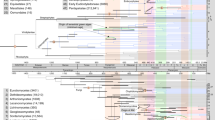Abstract
The three major groups of terrestrial fungi (Ascomycetes, Basidiomycetes, and Zygomycetes) are believed to have evolved from a member of the aquatic group Chytridiomycetes that associated with terrestrial plants, either as a saprophyte of dead plant material or as a parasite of living plants (Pirozynski and Malloch, 1975). The earliest fossil evidence of land plants contain fungal remains that may be interpreted as chytridiomycetous and zygomycetous in nature (Kidston and Lang, 1921). These Early Devonian fungal remains have been interpreted as endosymbionts (Pirozynski and Malloch, 1975), but are probably saprophytes due to the degraded condition of host tissues in which mycelium is encountered (Kidston and Lang, 1921). It is evident that sometime after plants colonized land, symbiotic associations began to develop between plants and terrestrial fungal groups. Fossils containing roots from the Triassic were found to contain fungi (Zygomycetes) of the ecologically-important symbiotic association, known as vesicular-arbuscular mycorrhizae (Stubblefield, Taylor, and Trappe, 1987). It is unknown when or from what progenitor the Ascomycetes and Basidiomycetes evolved. It seems probable that the ancestor to these groups was zygomycetous and that their evolution was influenced by their association with land plants since they evolved as mycorrhizae, pathogens, and saprophytes of plant materials. It is within the Clavicipitaceae (Ascomycetes) that another type of fungal endosymbiont evolved. The family Clavicipitaceae contains members that are biotrophic parasites of insects, fungi, and plants. Within the groups that are parasitic on grasses, many are episymbiotic (superficial on host tissues), while some are endosymbiotic (colonize internal tissues of the host). In this chapter we will examine biological aspects of episymbiotic and endosymbiotic members of the Clavicipitaceae.
Access this chapter
Tax calculation will be finalised at checkout
Purchases are for personal use only
Preview
Unable to display preview. Download preview PDF.
Similar content being viewed by others
References
Bacon, C. W., and J. De Battista (1990). B. Rai, K. G. Mukerji, and G. R. Knudsen. Marcel Dekker, New Y
Clarke, B. B., J. F. White, Jr., C. R. Funk, Jr., S. Sun, and D. R. Huff (1997). Plant Disease (In press).
Clay, K. (1988). Ecology 69: 10–16.
Clay, K., T. N. Hardy, and A. M. Hammond, Jr. (1985). Oecologia 66: 1–6.
Diehl, W. W. (1950). Balansia and the Balansiae in America. U.S.D.A. monograph No. 4, U.S. Government Printing Office, Washington D. C., 98 pp.
Kidston, R., and H. W. Lang (1921). Transactions of the Royal Society of Edinburgh. 52: 855–902.
Koshino, H. T. Yoshihara, S. Sakamura, T. Shimanuki, T. Sato, and A. Tajimi (1989). Phytochemistry 28: 771–772.
Latch, G. C. M., L. R. Potter, and B. F. Tyler (1987). Annals of Applied Biology 111: 59–64.
Leuchtmann, A., and K. Clay (1988). Mycologia 80: 192–199.
Lewis, G. C., and R. O. Clements (1986). Journal of Agricultural Science, Cambridge 107: 633–638.
Petroski, R.J., R.G. Powell, and K. Clay (1992). Natural Toxins 1: 84–88.
Pirozynski, K. A., and D. W. Malloch (1975). Biosystems 6: 153–164.
Porter, J. K., C. W. Bacon, and J. D. Robbins (1979). Journal of Natural Products 42: 309–314.
Renner, S. A., and G. J. Samuels (1995). 73: S816–S823.
Spataforo, J. W., and M. Blackwell (1993). Mycologia 85: 912–922.
Stubblefield, S. P., T. N. Taylor, and J. M. Trappe (1987). American Journal of Botany 74: 1904–1911.
West, C. P., D. M. Oosterhuis, and S. D. Wullschleger (1990). Environmental and Experimental Botany 30: 149–156.
White, J. F., Jr., and T. L. Bultman (1987). American Journal of Botany 74: 1716–1721.
White, J. F., Jr., and C. Camp (1995). Symbiosis 18: 15–25.
White, J. F., Jr., and A. E. Glenn (1994). American Journal of Botany 81: 216–223.
White, J. F., Jr., A. E. Glenn, and K. F. Chandler (1993). Mycologia 85: 195–202.
White, J. F., Jr., T. I. Martin, and D. Cabrai (1996). Mycologia 88: 174–178.
White, J. F., Jr., and J. R. Owens (1992). Applied Environmental Microbiology 58: 513–519.
Author information
Authors and Affiliations
Editor information
Rights and permissions
Copyright information
© 1999 Springer Science+Business Media Dordrecht
About this chapter
Cite this chapter
White, J.F., Reddy, P.V., Bacon, C.W., Cabral, D. (1999). The Mysterious Interrelationships Between Fungi and Plants: The Case of Endosymbionts. In: Seckbach, J. (eds) Enigmatic Microorganisms and Life in Extreme Environments. Cellular Origin and Life in Extreme Habitats, vol 1. Springer, Dordrecht. https://doi.org/10.1007/978-94-011-4838-2_52
Download citation
DOI: https://doi.org/10.1007/978-94-011-4838-2_52
Publisher Name: Springer, Dordrecht
Print ISBN: 978-1-4020-1863-3
Online ISBN: 978-94-011-4838-2
eBook Packages: Springer Book Archive




